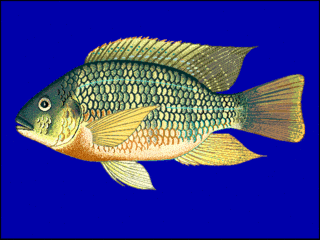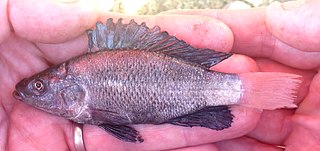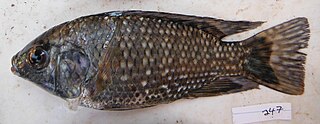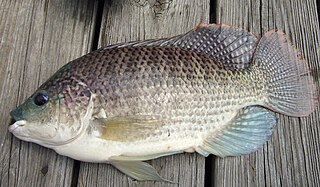
Tilapia is the common name for nearly a hundred species of cichlid fish from the coelotilapine, coptodonine, heterotilapine, oreochromine, pelmatolapiine, and tilapiine tribes, with the economically most important species placed in the Coptodonini and Oreochromini. Tilapia are mainly freshwater fish inhabiting shallow streams, ponds, rivers, and lakes, and less commonly found living in brackish water. Historically, they have been of major importance in artisanal fishing in Africa, and they are of increasing importance in aquaculture and aquaponics. Tilapia can become a problematic invasive species in new warm-water habitats such as Australia, whether deliberately or accidentally introduced, but generally not in temperate climates due to their inability to survive in cold water.
The Wami tilapia is a tilapiine cichlid that grows to over 20 cm in length and is considered a useful food fish in Tanzania and the island of Zanzibar, where it may have been introduced by man. It is tolerant of brackish water and grows well in saline pools, making it particularly suitable for aquaculture by communities living close to the sea. Like other tilapia it is an omnivore and will feed on algae, plants, small invertebrates, and detritus. The common name refers to the Wami River.

The Nile tilapia is a species of tilapia, a cichlid fish native to the northern half of Africa and the Levante area, including Jordan, Palestine, Israel, and Lebanon. Numerous introduced populations exist outside its natural range. It is also commercially known as mango fish, nilotica, or boulti. The first name leads to easy confusion with another tilapia which is traded commercially, the mango tilapia.

Oreochromis is a large genus of oreochromine cichlids, fishes endemic to Africa and the Middle East. A few species from this genus have been introduced far outside their native range and are important in aquaculture. Many others have very small ranges; some are seriously threatened, and O. ismailiaensis and O. lidole possibly are extinct. Although Oreochromis primarily are freshwater fish of rivers, lakes and similar habitats, several species can also thrive in brackish waters and some even survive in hypersaline conditions with a salinity that far surpasses that of seawater. In addition to overfishing and habitat loss, some of the more localized species are threatened by the introduction of other, more widespread Oreochromis species into their ranges. This is because they—in addition to competing for the local resources—often are able to hybridize.

Sarotherodon is a genus of oreochromine cichlids that are native to the northern half of Africa, with a single species, S. galilaeus, also ranging into the Levant. A couple of species from this genus have been introduced far outside their native range, and are important in aquaculture. Most other species have small ranges and some are seriously threatened. They mainly inhabit fresh and brackish water, but a few can live in salt water. Species in this genus, as well as those in several other oreochromine and tilapiine genera, share the common name "tilapia" and historically they were included in the genus Tilapia.

Tilapia has become the third most important fish in aquaculture after carp and salmon; worldwide production exceeded 1.5 million metric tons in 2002 and increases annually. Because of their high protein content, large size, rapid growth, and palatability, a number of coptodonine and oreochromine cichlids—specifically, various species of Coptodon, Oreochromis, and Sarotherodon—are the focus of major aquaculture efforts.
Throughout much of the tropics, tilapiine cichlids native to Africa and the Levant have been widely introduced into a variety of aquatic systems. In the U.S. states of Florida and Texas, tilapia were originally introduced to curtail invasive plants. In an effort to meet the growing demand for tilapia, humans have farmed these fish in countries around the world. Capable of establishing themselves into new ponds and waterways, many tilapia have escaped aquaculture facilities across much of Asia, Africa, and South America. In other cases, tilapia have been established into new aquatic habitats via aquarists or ornamental fish farmers.

The Mozambique tilapia is an oreochromine cichlid fish native to southeastern Africa. Dull colored, the Mozambique tilapia often lives up to a decade in its native habitats. It is a popular fish for aquaculture. Due to human introductions, it is now found in many tropical and subtropical habitats around the globe, where it can become an invasive species because of its robust nature. These same features make it a good species for aquaculture because it readily adapts to new situations. It is known as black tilapia in Colombia and as blue kurper in South Africa.

Alcolapia is a genus of small fishes in the family Cichlidae. Their native range is restricted to margins of Lake Natron and Lake Magadi, as well as similar conditions in nearby hot springs, in Kenya and Tanzania. They live in waters that are warm, hypersaline and alkaline. Species from this genus have also been introduced to Lake Nakuru and Lake Elmenteita. They are the only fish in their range.

Oreochromis amphimelas is a species of tilapia cichlid endemic to north–central Tanzania, where it is found in Lake Manyara and a number of other saline lakes with closed basins. Maximum recorded size is 28 cm (11 in) in standard length.
Oreochromis chungruruensis, the Kiungululu tilapia, is a species of cichlid fish that is endemic to Lake Chungruru, a small isolated crater lake in the Rungwe District in southern Tanzania. This species reaches up to 15.4 cm (6.1 in) in standard length and 19.5 cm (7.7 in) in total length. It is critically endangered due to overfishing and non-native tilapia species that have been introduced to Lake Chungruru.
Oreochromis esculentus, the Singida tilapia or Graham's tilapia, is a critically endangered species of cichlid endemic to the Lake Victoria basin, including some of its satellite lakes such as Kyoga, in Tanzania, Uganda, and Kenya. Its common name refers to Lake Singida, but this population is the result of an introduction that happened in the 1950s. This fish is highly valued by local fishermen, who know it as ngege.

The Lake Chala tilapia is a species of cichlid fish that is endemic to Lake Chala, a small crater lake on the border of Kenya and Tanzania. It mostly lives in relatively deep water, at depths between 20–45 m (66–148 ft). It is considered critically endangered by the IUCN with the primary threats being deterioration of its habitat due to siltation, and other non-native tilapia species that have been introduced to Lake Chala. Before these introductions, the Lake Chala tilapia was the only fish in Lake Chala. It is very closely related to the similar Jipe tilapia, another highly threatened species from the same general region of Kenya and Tanzania. The Lake Chala tilapia can reach a standard length of up to 30 cm (12 in).
Oreochromis jipe, the Jipe tilapia, is a critically endangered species of cichlid fish native to Kenya and Tanzania, where it is restricted to Lake Jipe and the Pangani River. The population in the Pangani River shows some morphological differences compared to the population in Lake Jipe, and it is sometimes recognized as a separate species, the Pangani tilapia. Whether regarded as one or two species, the Jipe–Pangani tilapia forms a species flock with the threatened Lake Chala tilapia from the same general region of Kenya and Tanzania.

Oreochromis leucostictus is a species of cichlid native to Albertine Rift Valley lakes and associated rivers in DR Congo and Uganda. It has now been introduced widely elsewhere East Africa, and is believed to have negative ecological impact, particularly on native tilapias. This species is reported to reach a standard length of up to 36.3 cm (14.3 in), but is usually much smaller. It is exploited by small-scale fishery and aquaculture operations.

Oreochromis variabilis, the Victoria tilapia, is a critically endangered species of African cichlid native to Lake Victoria and its tributaries, Lake Kyoga, Lake Kwania, and Lake Bisina (Salisbury), as well as being found in the Victoria Nile above Murchison Falls. This species can reach a standard length of 30 cm (12 in). This species is important to local commercial fisheries and is potentially important in aquaculture. It is also found in the aquarium trade.

The blue tilapia is a species of tilapia, a fish in the family Cichlidae. Native to Northern and Western Africa, and the Middle East, through introductions it is now also established elsewhere, including parts of the United States, where it has been declared an invasive species and has caused significant environmental damage. It is known as the blue kurper in South Africa.

Oreochromis andersonii, the three-spotted tilapia, threespot tilapia, or threespot bream, is a species of cichlid native to Africa, where it is found in rivers and swamps in the southern half of the continent. This species reaches a length of 61 cm (24 in). It is important to local commercial fisheries, as well as being commercially farmed. It is also popular as a gamefish. The identity of the person honoured in the specific name of this fish is not known but it is though most likely to be the Swedish explorer and hunter Charles John Andersson (1827-1867) who explored much of Namibia where the type was collected.

The redbelly tilapia, also known as the Zille's redbreast tilapia or St. Peter's fish, is a species of fish in the cichlid family. This fish is found widely in fresh and brackish waters in the northern half of Africa and the Middle East. Elsewhere in Africa, Asia, Australia and North America, it has been introduced as a food fish or as a control of aquatic vegetation. Where introduced, it sometimes becomes invasive, threatening the local ecology and species. The redbelly tilapia is an important food fish and sometimes aquacultured.

Oreochromini is a tribe of cichlids in the Pseudocrenilabrinae subfamily that is native to Africa and Western Asia, but a few species have been widely introduced to other parts of the world. It was formerly considered to be part of the tribe Tilapini but more recent workers have found that the Tilapini sensu lato is paraphyletic. Despite this change, species in Oreochromini are still referred to by the common name tilapia and some of the most important tilapia in aquaculture —certain species of Oreochromis and Sarotherodon— are part of this tribe. In contrast, several species have small ranges and are seriously threatened; a few are already extinct or possibly extinct.














